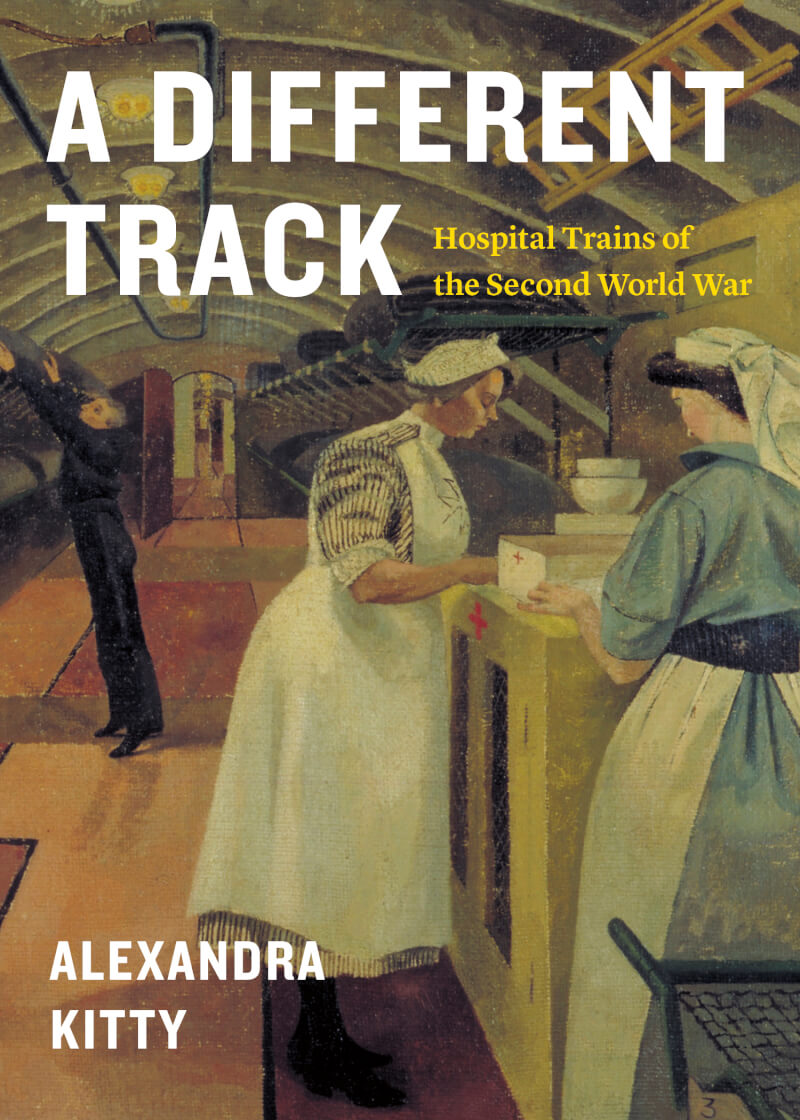
Access to railroad tracks during the Second World War meant the difference between defeat and victory, and life or death. It was often a wheel of fortune as much as it was a lifeline: your fate strictly depended on whether you reached the train in time, and what train came your way. War is always chaotic by nature; even a shrewd, cunning and vigilant person can have providence work against the most ingenious of plans. As such, railroads were essential to stacking the odds in a society’s favour under the worst and most unpredictable of circumstances.
Trains brought food, munitions, and salvation. They provided an escape, but many times they also brought ruin and doom. Holocaust victims were sent to their deaths, and for some, the weapons were brought to their enemies to kill them. The wheels spun in every direction even as the tracks moved in a single line. Yet there was one kind of train where the chances of survival greatly increased with its arrival: the hospital train.
Hospital trains were not new in the Second World War. Ambulance trains were employed in the Great War and evolved from there. In the First World War, there were 21 such trains in both the U.K. and France, operated by the American Expeditionary Forces. By the time the Second World War exploded, the U.K. had converted regular trains into moving emergency wards to tend to those critically wounded; it was an elegant solution as train cars could be refitted with tier beds and supplies could be easily transported along with medical staff.
However, the psychological and emotional importance of the hospital trains, particularly in the Second World War, is often missed in our history books. We have all seen haunting images of genocide victims being boarded onto trains to meet their tortuous end in concentration camps. Whereas those trains brought certain death, the hospital trains brought life; the trains carrying innocent civilians to torture, starvation and slaughter were symbols of chaos, while the hospital trains represented the order that brought people back from the brink of death with healing, care and the latest medical equipment and medicine. These trains were as important as the troops who came to liberate and defend, and those who worked inside them bought soldiers and civilians alike enough time and space to survive and procure a victory.

Hospital trains were not new in the Second World War. Ambulance trains were employed in the Great War and evolved from there.
From surgeries to amputations to delivering babies, the trains were about preserving life. Often, the medical staff on board were short-staffed, overworked and undersupplied, yet they did their jobs. Amputations without anesthesia were performed, and frequently, but the result was still triumph.
The mobile hospital brought patients to conventional hospitals, and to other mobile hospitals such as ships, but delicate procedures were often performed en route, day or night, during calm and during battle. What needed to be done was done. There were secondary uses for the trains, including rescuing children who had lost their parents through war or concentration camps, picking them up to take them to orphanages. The healthcare staff on these trains did more than just heal the physically wounded: they also gave emotional and psychological comfort to the patients as well as the personnel. The trains were a mobile hospital in every sense of the word, with contained dining areas, kitchens, offices, surgical cars, pharmacies and sleeping quarters. They were revered in the press and were a sign of a nation’s might as much as troop size and weaponry.
The Evening Star had a piece on Jan.18, 1942, that was dedicated to the trains under the banner “The Noblest Act:”
“We had 262 on board and there was the smell of death in the carriages…. We were, technically, on neutral soil now. Here were big Red Crosses on our rooftops. The enemy would not bomb or strafe us here. The war was over for us, temporarily. For the men back there the war was over too, permanently.”
The article went on to describe why the trains became “neutral territory” during the war:
“Some of the wounded were what you call “walking wounded.” They weren’t hurt badly enough to give them beds in the hospital cars. Our coach was half second-class compartments and half third-class. The third-class half was filled with Italian and German prisoners. They were hungry too. You don’t pamper the wounded on the trains. You shove them aboard and move them off. They get water and there’s some thin soup for the bad cases, but the object is to get them to hospitals in Cairo and Alexandria.”
News reports about the trains were common and described their varied uses. On home territory in the U.S., the trains were often used to give medical personnel practical experience before they were shipped off to foreign soil. Trains were not just equipped with healing staff, but also recreation workers; these workers, often overlooked, were called pioneers in news reports. Cards, maps, reading material, stationery, cigarettes and comfort articles were distributed. It is interesting that what seems mundane now was considered newsworthy and prestigious in its time.
Hospital trains were an integral part of understanding the war. Their ubiquitous presence became an essential part of the war narrative, as outlined in the January 1944 edition of the Bulletin of the United States Army Medical Department, the trains were planned to the meticulous last detail:
“A ten-car hospital train has recently been delivered to the Desert Training Center in California. It was furnished by the Transportation Corps in accordance with the requirements of the Medical Department. The manufacturer was Pullman-Standard Car Manufacturing Company, Worcester, Massachusetts.
This train is made up of six ward cars, one utility car, one officer personnel car, one orderly car and one kitchen, dining and pharmacy car. Each car is 44 feet long, mounted on two four-wheel trucks. The usual vestibules at each end of the car are omitted and two wide doors, one in the centre of each side, are substituted to receive and discharge litter patients.
The ward car provides eight two-tier bunks, sanitary service facilities, medicine cabinet and an ash tray and water glass receptacle at each bunk. A folding support is included to hold a litter for emergency use. Folding seats are provided in front of the entrance doors for use when doors are closed.
The utility car is provided with two Vapor Clarkson Steam Generators, and two 15-KVA Diesel electric generators. A shower bath and locker space are also included.
The officer personnel car serves as living quarters for four officers at one end and six nurses at the other. Shower, toilet, and locker space are provided for each group. A writing desk, water cooler and folding seats are available for general use at the center of the car.
The orderly car bunks are the same as those in the ward car. However, the centre area is provided with two toilets and lockers in lieu of the sanitary service facilities for patients.
The kitchen, dining, and pharmacy car combines a complete kitchen for the personnel and patients, dining table service for sixteen with two serving tables, and a small pharmacy complete with work table, sink, cabinets, and desk.”
Hospital trains were an integral part of understanding the war.
The trains were a central artery that gave hope and life, but once the Second World War drew to a close, the same majestic vehicles lost their rightful place in history. A Different Track: Hospital Trains of the Second World War explores how the hospital trains came to be, how they operated, their triumphs and tragedies and, most importantly, how they contributed to the restoration of peace, from Europe to Africa to North America. From their critical role in Dieppe to even their use in the U.S. to evacuate soldiers from one hospital to another, these were the rides to salvation. War is chaos, but even in chaos, there is order, and the hospital trains delivered that order in various ways until the end of the war. Eventually, hospital trains fell out of favour after the war (though they are still in use in places such as India), but their quiet imprint on history cannot be ignored. The workers were the people who added more grains to the hourglass, ensuring that time would eventually favour order over chaos.
Advertisement












